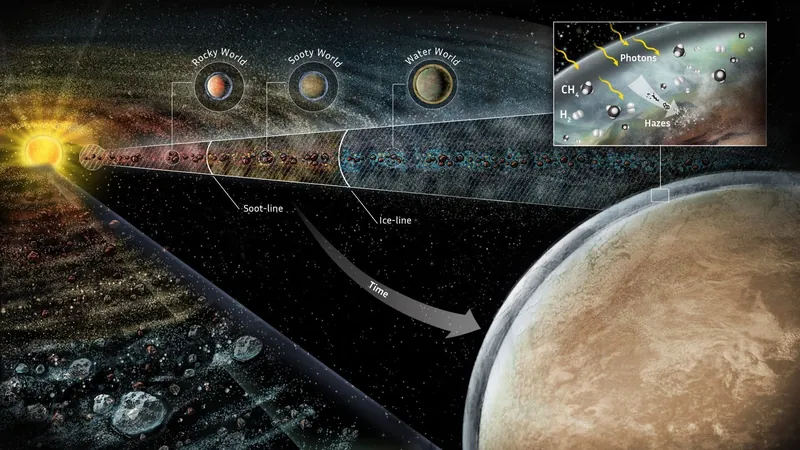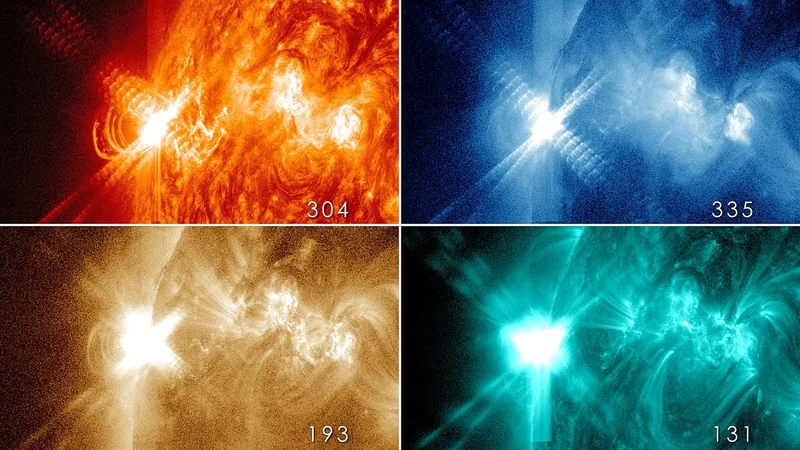
Forget Water Worlds! Are 'Soot Planets' the New Frontier of Astronomy?
2025-09-01
Author: Jacob
Astronomers have long believed that water worlds are among the most common planets in the universe, giving rise to many sci-fi dreams—no, not the Kevin Costner kind! However, a groundbreaking new study from Jie Li and their team at the University of Michigan proposes a surprising contender: soot planets.
But what exactly is a soot planet? In astronomical terms, soot doesn't refer to what you’d sweep out of a fireplace. Instead, it’s a complex compound referred to as "refractory organic carbon," or CHON, which could redefine our understanding of planetary formation.
Curiously, soot is not a rarity in our solar system. Estimates suggest that it constitutes nearly 40% of the mass of comets. This suggests that during the solar system's formative years, soot was prevalent—potentially hinting at its role in the birth of planets.
The Soot Line: A New Horizon in Planetary Formation
According to the new research, there might exist a "soot line"—a threshold past which soot remains stable and can contribute to planet formation. This line is thought to be significantly closer to the sun than the well-known "snow line," where water ice can exist.
The study identifies three distinct zones within protoplanetary disks. The innermost zone generates rocky planets like Earth and Mars, too hot for soot to thrive. The middle zone, however, could birth soot-rich planets with minimal water, resembling Titan, Saturn's moon, which has a methane-dominated atmosphere.
Soot-Water Hybrids: A Recipe for Cosmic Diversity?
Farther from the sun lies the snow line, where planets take on a mixed composition of soot and water. The study outlines two models of these "soot-water worlds": a "dry" variant with 25% water, and a "wet" version consisting of half water, both containing significant amounts of soot. Fascinatingly, these combinations make it nearly impossible to distinguish between soot worlds and traditional water worlds based solely on their mass and size.
This challenge in differentiation raises questions about many exoplanets previously classified as water worlds, including those labeled as "mini-Neptunes." Atmospheric analysis might hold the key to finding out if these exoplanets have carbon-rich atmospheres instead!
The James Webb Space Telescope: Pioneering the Search for Soot Planets
The James Webb Space Telescope is already delving into this mystery, analyzing the atmospheres of exoplanets like K2-12b and TOI-280d. Interestingly, TOI-280d has a notably high carbon-to-oxygen ratio, which suggests it could indeed be a soot planet.
The implications of these findings are both thrilling and complex. While soot planets may possess diamond cores—which could impede the cycling of vital elements for life—they're also rich in volatile organics like methane. These compounds are crucial in prebiotic chemistry and could present unique opportunities for habitability.
What’s Next for Astronomers?
Ultimately, understanding these enigmatic soot worlds requires further exploration. More atmospheric studies and improved models are essential to clarify the differences between soot and water worlds.
While astronomers continue their research, let’s not forget the ever-inventive filmmakers out there—there's a story waiting to be told about adventurers sailing across the methane seas of a distant soot planet. After all, Kevin Costner is still in the game!









 Brasil (PT)
Brasil (PT)
 Canada (EN)
Canada (EN)
 Chile (ES)
Chile (ES)
 Česko (CS)
Česko (CS)
 대한민국 (KO)
대한민국 (KO)
 España (ES)
España (ES)
 France (FR)
France (FR)
 Hong Kong (EN)
Hong Kong (EN)
 Italia (IT)
Italia (IT)
 日本 (JA)
日本 (JA)
 Magyarország (HU)
Magyarország (HU)
 Norge (NO)
Norge (NO)
 Polska (PL)
Polska (PL)
 Schweiz (DE)
Schweiz (DE)
 Singapore (EN)
Singapore (EN)
 Sverige (SV)
Sverige (SV)
 Suomi (FI)
Suomi (FI)
 Türkiye (TR)
Türkiye (TR)
 الإمارات العربية المتحدة (AR)
الإمارات العربية المتحدة (AR)